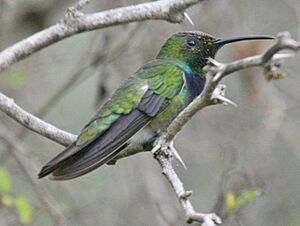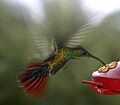Green-breasted mango facts for kids
Quick facts for kids Green-breasted mango |
|
|---|---|
 |
|
| Conservation status | |
| Scientific classification | |
| Genus: |
Anthracothorax
|
| Species: |
prevostii
|
 |
|
The green-breasted mango (Anthracothorax prevostii) is a type of hummingbird. It's also sometimes called Prevost's mango. You can find this beautiful bird in eastern Mexico, through most of Central America, and in parts of Colombia and Venezuela. Sometimes, it even flies far north and visits the United States!
Contents
About the Green-breasted Mango
Naming and Family Tree
Scientists give every living thing a special name, like a first and last name, to help keep track of them. The green-breasted mango's scientific name is Anthracothorax prevostii. It belongs to the hummingbird family, called Trochilidae.
This bird was first described in 1832. Over time, scientists have studied it more and decided it has four main types, called subspecies, which are like different versions of the same bird:
- A. p. prevostii
- A. p. gracilirostris
- A. p. hendersoni
- A. p. viridicordatus
The second part of its scientific name, prevostii, honors a French scientist named Florent Prévost.
What Does It Look Like?
The green-breasted mango is about 10 to 12 centimeters (4 to 4.8 inches) long. It weighs around 5.7 to 7 grams (0.2 to 0.25 ounces), which is about the weight of a few paper clips! Both male and female birds have a slightly curved, dull black beak.
Adult males of the most common type (A. p. prevostii) are very colorful. They have shiny, metallic bronze-green feathers on their head, neck, and back. Their tail feathers are mostly purple with a metallic shine. Their wings are a dark brownish-gray. They have a velvety black stripe down their chin, throat, and chest, with shiny bluish-green on the sides. Their belly and sides are bronze-green.
Female green-breasted mangoes are also pretty, but a bit less shiny than the males. Their green feathers are less bronzy. Their outer tail feathers are blue-black with white tips. They have a black stripe on their chin and throat, but it turns bluish-green on the chest and dusky on the belly, with a white border.
Young birds look a lot like adult females, but they have a white chin, throat, and chest, sometimes with some chestnut-colored spots.
The different subspecies have small differences in how they look:
- A. p. gracilirostris has a shorter, thinner beak.
- A. p. hendersoni also has a shorter beak and a longer, thinner bluish-black stripe.
- A. p. viridicordatus has bright grass-green upper parts.
Where Do They Live?
The green-breasted mango lives in many different places, mostly in warm, tropical lowlands. They like areas that are partly open, like:
- Shrublands with trees
- Savannas (grassy plains with scattered trees)
- Younger forests that are growing back
- Forests along rivers
- Mangrove swamps
- The edges of thicker forests
You can also find them in places where people live, like farms, parks, gardens, and even in towns and cities. They usually live from sea level up to about 500 meters (1,600 feet) high, but sometimes they can be found as high as 1,100 meters (3,600 feet) in Central America.
The different subspecies are found in specific areas:
- A. p. prevostii lives from Mexico south to Guatemala, Belize, and El Salvador.
- A. p. gracilirostris lives from El Salvador south through Honduras, Nicaragua, and Costa Rica into Panama.
- A. p. hendersoni lives on Providencia and San Andrés islands near Nicaragua.
- A. p. viridicordatus lives in parts of northeastern Colombia and coastal Venezuela.
Some of these birds, especially the A. p. prevostii type, sometimes fly far away from their usual homes. They have been seen in the United States, with many sightings in Texas and a few in other states like North Carolina, Wisconsin, Georgia, and Louisiana.
Green-breasted Mango Behavior
Movement and Migration
Some green-breasted mangoes that live in northern Mexico move south during the cooler months, from September to February. They usually go to the Pacific coast of southern Mexico and El Salvador. Most other green-breasted mangoes stay in the same area all year round.
What Do They Eat?
Green-breasted mangoes eat two main things: nectar from flowers and small arthropods (like insects and spiders). They look for food at all levels of their habitat, from low bushes to the tops of tall trees.
They get nectar from many different kinds of flowering plants, including trees, vines, and shrubs. They also love to visit sugar water feeders that people put out. They hover in the air while they drink nectar.
To catch insects and spiders, they often perch on a branch and then quickly fly out to snatch a bug from the air. They also pick insects off plants and spider webs.
Life Cycle and Reproduction
The breeding season for the green-breasted mango changes depending on where they live. In some areas, it's from March to June. In El Salvador, it's from October to February. Further south in Central America, they might nest at any time of the year! They often have two sets of babies in one year.
The female bird builds a small, cup-shaped nest. She uses soft plant fibers and decorates the outside with tree bark and lichens. She holds it all together with spider silk. Sometimes, she even lines the inside with tiny feathers.
She usually builds her nest on a bare, flat branch high up in a tree, sometimes as high as 30 meters (100 feet)! But they have also been seen building nests on human-made things like wires, fences, and antennas.
A female green-breasted mango usually lays two eggs. She takes care of the eggs and the baby birds all by herself. Scientists don't know exactly how long the eggs take to hatch or how long it takes for the baby birds to fly out of the nest.
Sounds and Calls
The green-breasted mango isn't a very loud bird, but it does make some interesting sounds. Its song is a buzzing, repeated sound that goes "tsi si-si-si si-si-si."
It also has different calls:
- A short, high, sharp "sip" or "sik" when it's flying.
- A harsh "chik chik chik" when it's eating or resting.
- A high, shrill, slightly metallic twittering sound when it's arguing with another bird.
Conservation Status
The IUCN (International Union for Conservation of Nature) has looked at the green-breasted mango and decided it is a species of "Least Concern." This means they are not currently worried about it becoming endangered.
This bird lives in a very large area, and there are at least half a million adult birds. Even though the number of birds might be slowly going down, there are still plenty of them. Scientists haven't found any big, immediate threats to the species.
Because these birds are common in places changed by humans, like farms, parks, and neighborhoods, they might even benefit from some changes to the land.
In the U.S., the green-breasted mango is protected by the Migratory Bird Treaty Act.
Images for kids




